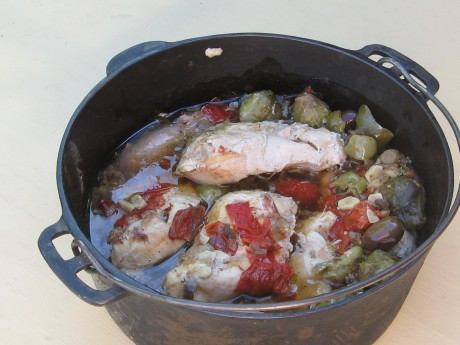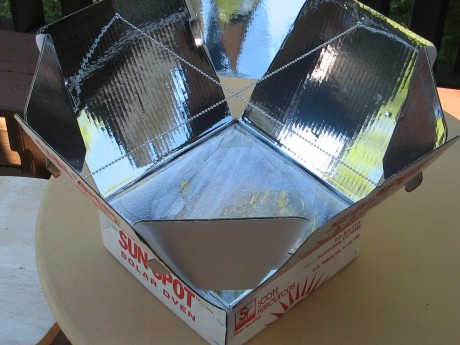
My neighbor, Jan, recently purchased a solar oven and has been having fun experimenting with it. Besides casseroles she has made corn bread and cookies. The experimental stage. Her oven is a pretty fancy affair and most likely performs better than mine. About twenty years ago, I did the same thing. I bought a solar oven, a very simple affair of folded cardboard with aluminized sides, and that’s it folks. I’d have friends come up from the Bay Area, throw a chicken and some veggies in the black pot, stick it in the solar oven and go wine tasting or trekking antique stores with them. Then come home to a fully cooked casserole. Delicious and easy.

I wore out my original one, and made a couple of them at home out of card board boxes and aluminum foil. They didn’t work as well. I baked cookies once on a plastic form that I had from a recent purchase and the plastic melted on one end showing me that the heat in my cardboard box was uneven. The cookies all turned out fine. I should have used a Styrofoam meat tray for my cookie tray instead. Everyone I’ve fed a meal from my solar oven is amazed at how good the food tastes. Jan inspired me to get out my solar oven and put this heat we’ve been having to good use. I was expecting company and here is what I cooked:
I placed six Italian Sausage in the bottom of the (black is required even if you have to paint it black) pan. Over them I placed six chicken breasts. I added a 1/2 cup of chicken broth, 1/4 cup garlic wine vinegar, and several sprigs of fresh thyme then covered everything with veggies. Two cloves of garlic, crushed and sliced, some mixed deli black and green Mediterranean olives with a bit of the juice,; a diced half of red onion, a small red bell pepper, about ten frozen brussels sprouts, a peproncini and a hot prosciutto stuffed pepper that also came from the deli Mediterranean olive mix available at practically any grocery store these days. I cut it up small to spread the flavor around. (I’ve also made this dish with six preperoncini from a jar without the olives, but I liked the olive mixture better.) A meal like this will cook in about two to four hours, depending on how bright the sun is, meaning, summer like now. In winter, it takes longer. You also have to have full sun on your cooker the whole time. With my trees grown so tall, I now have to move my cooker around to keep it in full for more than two hours.

The finished casserole looked like this. It was absolutely yummy. I might mention Jan hates brussels sprouts, but loved them from the solar oven. No bitterness, wonderfully tender and sweet. The best benefit of cooking in a solar oven, is you can’t over cook or burn anything.

I served this over rice, cooked in a solar hot pot. I could have put the rice in the casserole, and have done that with good results. Or next to the casserole in it’s own black pot. But I like having the little solar hot pot for heating up leftovers while I type, or cooking polenta without stirring, or a sweet side dish like carrots with butter, red wine and brown sugar. It also bakes a single layer of a cake mix or six cupcakes fitted into a round single layer cake pan. Both ovens fold up into a small package, by the way. The other thing I like about solar ovens is that if you buy one from Solar Cookers International, you can share with third world countries a cooking concept that is easy to build, easy to use, saves trees and expensive fuel, usually gas or oil, for people who live without power in remote villages. Of course, solar ovens also serve people who live in regular housing as well. SCI is a non-profit organization that delivers five solar ovens to people that need them for every one that you buy. A great $25 donation. There web site is: http://www.solarcookers.org/index.html
But, if you type in solar cooking, or solar cookers in your search engine, all of the solar companies will pop up. It makes for some interesting choices. In Africa, for instance, they have small restaurants that operate on big solar cookers. They make solar “fryers”, and give you directions on how to make one at home from a disguarded television dish that the companies never come and pick up. Its a fun read and a fun thing to do. Great for the RV life and the environment. What’s not to like?
No comments:
Post a Comment